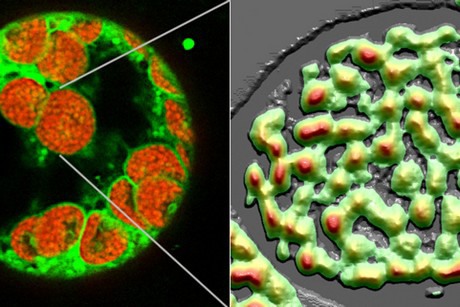Plants take sunlight and turn it into energy, but scientists are still figuring out exactly how they do this complex conversion.
“Photosynthesis can be dangerous,” said Helmut Kirchhoff, an associate professor in WSU’s Institute of Biological Chemistry. “At the point where light is collected, the energy is there. That energy has to be deactivated right away and transferred to different parts of the plant or it can damage the plant.”
Because sunlight fluctuates—with clouds or as the sun travels and shadows are cast–plants react to different light environments to stay safe and not make more energy than they can process, Kirchhoff said.
Now Kirchhoff and his colleagues have developed a way to monitor how plants adjust these photosynthetic functions.
“We developed a way to measure the components of this energy converting machinery,” he said. “To understand the process, you have to know the exact ratio of components. And now we can measure that.”

A zoomed in view of thylakoid membranes inside chloroplasts in a plant. The membranes are where light is transformed into energy in plants.
Kirchhoff’s results are available in the February 2019 issue of The Plant Journal. His article, “The structural and functional domains of plant thylakoid membranes,” is featured on the cover. The journal also highlighted the research with this story.
While the breakthrough needs to be researched further, Kirchhoff said this could be the first step to more efficient plant breeding programs.
“This is really basic science, but the more we learn the easier it will be for other people to use this knowledge to help growers and everyone else,” he said. “A better understanding of photosynthetic energy conversion is really important. And we’ll keep working to learn as much as possible.”
The work was supported by a grant from the National Science Foundation, NSF-MCB 1616982.
